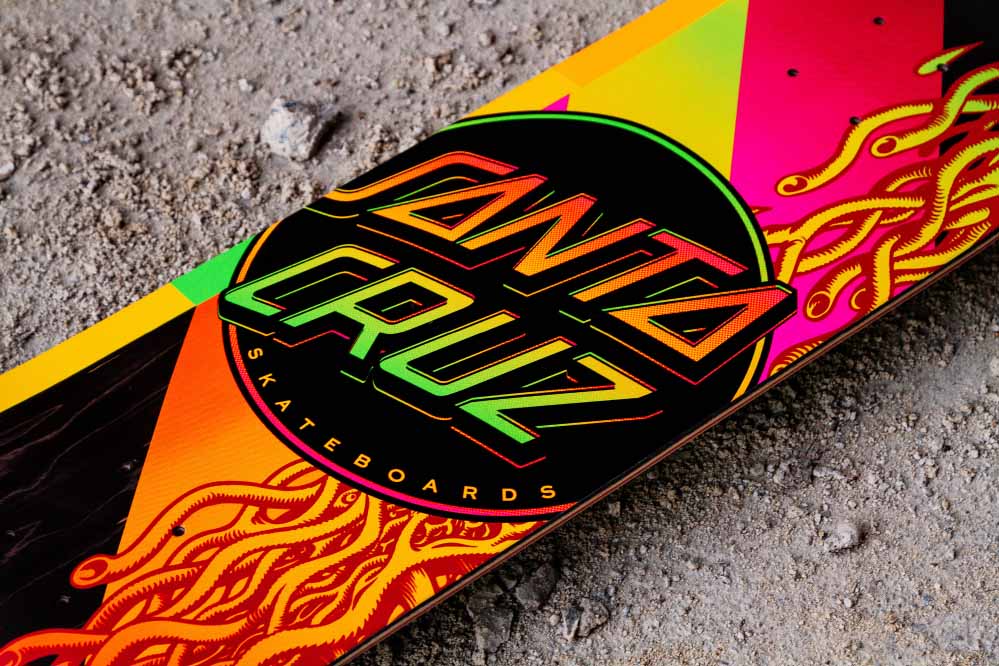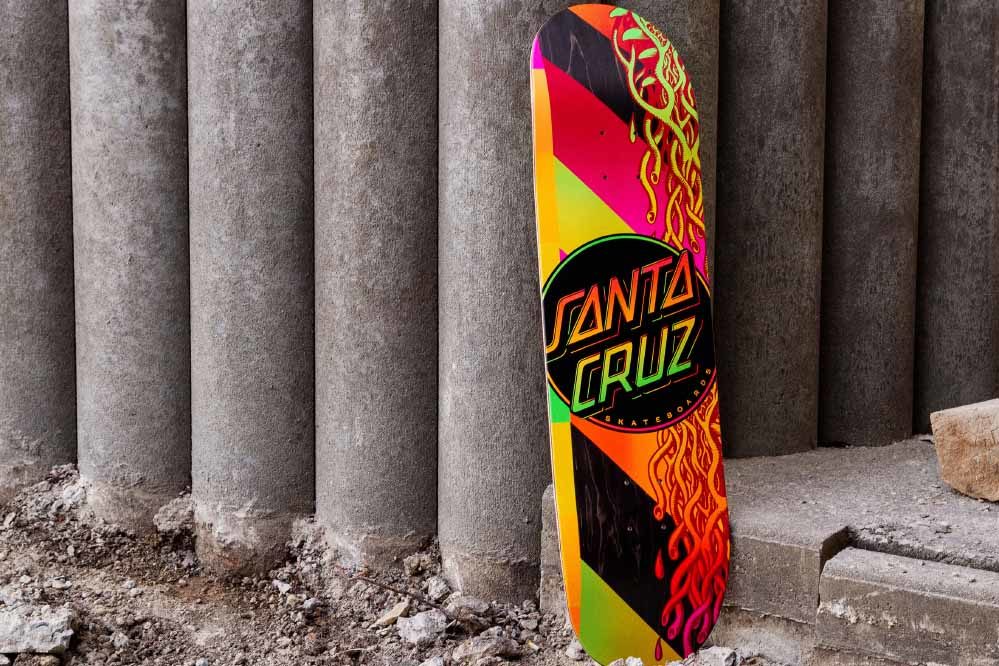The Santa Cruz VX decks are said to be thinner & stronger skateboard decks with more pop. In this review we look at what the hype is all about and whether the VX technology lives up to its promises.
READ IN ANOTHER LANGUAGE
DE | FR | NL

Before we start: Why buy a VX deck?
I was especially interested in testing the Santa Cruz VX deck because of the following: I was looking for a deck that I could use to skate flat bars, without hesitation or fear of breaking the deck. I also wanted something a bit smaller than my usual 8.38″ deck and one that would flip more easily.
My train of thought was that a Slick deck might be too heavy and a smaller skateboard could break with one wrong move. I weigh about 82kg – not all that heavy, but not particularly light either. I skate in park more than in the street (a ratio of about 2:1). I normally need a new deck every month if they even last that long.
The Santa Cruz VX technology explained
In comparison to regular 7-ply decks, the Santa Cruz VX Skateboard decks consist of 5 plies of maplewood and 2 layers of “Quad X Technology“. The Quad X layers combine fiberglass and carbon fiber fabric, which are connected crosswise with each other. These special plies make up the top and second to last layer of VX decks. All in all, this is supposed to make decks with VX technology thinner & stronger, as well as give you a longer-lasting pop.
First Impression: Santa Cruz VX Skate Test
Two things I immediately noticed were how much thinner the board looked and felt. The sleek matte finish of the top sheet also caught my eye. Setting up the new board, it seemed more difficult to get the screws through the Quad X layers. In exchange, however, the matte finish on top is supposed to make it easier for you to change griptape.
Before getting into the test, I weighed the Santa Cruz 8.25″ VX deck and it was 5 grams more than my old 8.38″ Real Full Shape deck. Bear in mind that a used board is somewhat lighter than a new one because some of the wood has been worn away. Therefore, the VX decks appear to be thinner but are more or less comparable in weight to regular 7-ply decks.
First session & shape of the Santa Cruz VX board
I started my review with the fresh setup at the local park and would say I got comfortable with its shape pretty quickly. It did actually feel smaller, but not tiny. I’m used to boards with a lot of room on the nose and tail. In comparison to my previous board (Real Full shape), the difference wasn’t that noticeable.
The 8.25″ Santa Cruz VX deck is designed with a rather large, flat sliding space past the baseplates towards the nose and tail. This provides a lot of room to lock into slides properly and it made Manuals super fun and easier for me.
The steepness of the VX deck’s nose and tail can be seen with the naked eye, but in my opinion they’re still not overly long. I was positively surprised by this when doing my Ollies, but it also made flip tricks a bit more work in the beginning.
10 hours of substantial skating
I tried to run the Santa Cruz VX deck through every obstacle and style to get a good feel for it. Overall, it performed just like a regular board.
The VX deck is definitely more firm than a 7-ply, but also surprisingly flexible. I sometimes felt the flex more than usual, like when I’d jump on a flat bar or go from an Ollie to BS Disaster. But then it sprang right back into shape, most likely a direct result of the Quad X technology.
At one point during the second session, the board flew right into the corner of a ledge and I was suprised to see that the Quad X technology saved it from chipping. I only noticed a small nick, which is a big plus point. I even skated a rough barrier-style quarter and cut some deep lines into the wood; the Quad X layers didn’t seem to be affected at all.
20 hours and a heap of asphalt
After about 20 hours of skating mostly asphalt, I felt like flip tricks were still a bit harder than expected because the nose and tail felt as stiff and steep as they were when I started. At this point, its overall flexibility felt comparable to a brand new regular wooden deck.
Although the Santa Cruz VX deck was still locking beautifully into slides, the first signs of wear were appearing. The Quad X tech started to show through on the decks’ tail, having worn away into a thin layer of white stringy material. Nonetheless, it didn’t affect my skating at all.
30 hours and about time for new grip
After having skated the Santa Cruz VX deck for about a month, I was still amazed by the quality of its pop. The only downside was the razor tail, which could no longer be ignored – it was really worn down and got splintery and sharp around the edges.
I think this is the obvious setback downside of a board with fewer plies. On the bright side: flip tricks had started to feel normal by now. What’s more, the Quad X technology had prevented a lot of chipping and maintained the shape of the board pretty well.
The board had become more flexible at this point without feeling spongey. Would I regrip this board? If it wasn’t for the razor tail, yes!
The truth is, this board lasted me a lot longer than I expected (about 1.5 times) and the quality of the pop and lack of chipping made a big difference. If you only skate smooth parks, I can imagine it lasting twice as long as regular decks – as long as you’re not doing too many high-impact tricks.
Conclusion
“For some, an absolute game changer – for others, great pop for a bit more money”
Finally, the big question: Is the VX board worth the extra money? If you’re looking for a board that’ll last you a little longer for a little more money, then the VX Deck is a safe bet in most cases. I do not doubt that this board keeps its pop longer than a regular 7-ply board without chipping as easily. I even did a parallel test with my other deck and within the same timeframe of the Santa Cruz VX review, I noticed that the regular board lost its pop more quickly.
Pros
- Great, long-lasting pop
- Better resistance to chipping
- Long-lasting new board feel
- Almost weighs the same as a regular 7-ply board
- You don’t have to avoid those ‘might snap my board’ tricks
Cons
- Takes long to break in
- Razor tails easily
- Only a few different shapes and sizes
I tried to answer a few questions that could come to mind when considering buying a Santa Cruz VX deck.
Who is the VX technology board for?
It’s definitely for skaters who snap decks. In my eyes there’s no doubt that these decks last longer, whether you’re jumping down a set, trying a new trick that may end badly for your board, or if you’re simply a bigger person who doesn’t want to limit themselves out of fear of snapping their board.
Are VX decks for people that chip decks?
There’s not a huge difference, but rather a noticable improvement. However, the wood still reacts the same and does eventually chip after a lot of bails and misses. In my case, the technology helped the board keep its form longer.
Is it better for avoiding razor tail?
Not at all. It’s thinner and has fewer plies, so it actually gets there sooner.
Does it matter if you skate park or street?
For park skaters, I think this board is a game changer. It stays “crisp” longer which may require a longer break-in time. I would say you can skate a VX board for much longer depending on how high impact your skating is.
If you skate gritty streets that wear your board down quickly, I don’t think it would make that much of a difference for you. The VX technology helps to keep the board in good shape, but only to a certain extent.
I would say the smoother the spot, the better – whether it’s street or park.
Are VX decks for skaters that need to break in a board?
If you need a long time to break in a board, I think this board may be a bit frustrating for you, especially if the tail begins to sharpen just as you’re starting to get the feel of it.
Will I buy it again?
Absolutely! I think this is the future of longer-lasting boards; they also offer a lighter solution compared to Slick decks. The VX deck is great to learn new tricks on without fear of cracking it. Personally, I don’t think the price is a drawback because in my opinion this board will last longer for everyone, except perhaps for skaters who skate on very rough terrain or who don’t have the best manual skills yet.
